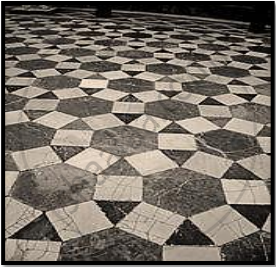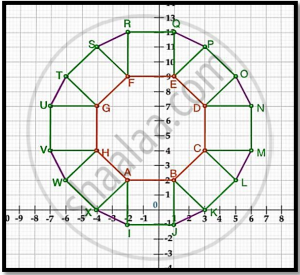Advertisements
Advertisements
प्रश्न
Find the area of quadrilateral ABCD whose vertices are A(-5, 7), B(-4, -5) C(-1,-6) and D(4,5)
उत्तर
By joining A and C, we get two triangles ABC and ACD .
`" let" A (x_1,y_1)=A(-5,7) , B(x_2,y_2) = B(-4,-5) , C (x_3,y_3) = c (-1,-6) and D(x_4,y_4) = D(4,5)`
Then
`"Area of" Δ ABC = 1/2 [ x_1 (y_2 -y_3) +x_2 (y_3-y_1) +x_3(y_1-y_2)]`
`=1/2[-5(-5+6)-4(-6-7)-1(7+5)]`
`=1/2[-5+52-12]=35/2` sq. units
`"Area of" Δ ACD = 1/2 [x_1(y_3-y_4)+x_3(y_4-y_1)+x_4(y_1-y_3)]`
`=1/2 [-5(-6-5)-1(5-7)+4(7+6)]`
`=1/2[55+2+52]=109/2 `sq. units
So, the area of the quadrilateral ABCD is `35/2+109/2=72 ` sq .units.
APPEARS IN
संबंधित प्रश्न
Prove that the points (3, 0), (6, 4) and (-1, 3) are the vertices of a right-angled isosceles triangle.
A (3, 2) and B (−2, 1) are two vertices of a triangle ABC whose centroid G has the coordinates `(5/3,-1/3)`Find the coordinates of the third vertex C of the triangle.
Name the quadrilateral formed, if any, by the following points, and given reasons for your answers:
A(-1,-2) B(1, 0), C (-1, 2), D(-3, 0)
Find the coordinates of the point which divides the line segment joining (−1,3) and (4, −7) internally in the ratio 3 : 4
If the point ( x,y ) is equidistant form the points ( a+b,b-a ) and (a-b ,a+b ) , prove that bx = ay
Show that the following points are the vertices of a rectangle
A (0,-4), B(6,2), C(3,5) and D(-3,-1)
The distance of the point P (4, 3) from the origin is
The area of the triangle formed by the points A(2,0) B(6,0) and C(4,6) is
If A(3, y) is equidistant from points P(8, −3) and Q(7, 6), find the value of y and find the distance AQ.
If A(−3, 5), B(−2, −7), C(1, −8) and D(6, 3) are the vertices of a quadrilateral ABCD, find its area.
\[A\left( 6, 1 \right) , B(8, 2) \text{ and } C(9, 4)\] are three vertices of a parallelogram ABCD . If E is the mid-point of DC , find the area of \[∆\] ADE.
The line segment joining points (−3, −4), and (1, −2) is divided by y-axis in the ratio.
The length of a line segment joining A (2, −3) and B is 10 units. If the abscissa of B is 10 units, then its ordinates can be
If A(4, 9), B(2, 3) and C(6, 5) are the vertices of ∆ABC, then the length of median through C is
Find the coordinates of point A, where AB is a diameter of the circle with centre (–2, 2) and B is the point with coordinates (3, 4).
If segment AB is parallel Y-axis and coordinates of A are (1, 3), then the coordinates of B are ______
The points whose abscissa and ordinate have different signs will lie in ______.
A tiling or tessellation of a flat surface is the covering of a plane using one or more geometric shapes, called tiles, with no overlaps and no gaps. Historically, tessellations were used in ancient Rome and in Islamic art. You may find tessellation patterns on floors, walls, paintings etc. Shown below is a tiled floor in the archaeological Museum of Seville, made using squares, triangles and hexagons.

A craftsman thought of making a floor pattern after being inspired by the above design. To ensure accuracy in his work, he made the pattern on the Cartesian plane. He used regular octagons, squares and triangles for his floor tessellation pattern

Use the above figure to answer the questions that follow:
- What is the length of the line segment joining points B and F?
- The centre ‘Z’ of the figure will be the point of intersection of the diagonals of quadrilateral WXOP. Then what are the coordinates of Z?
- What are the coordinates of the point on y-axis equidistant from A and G?
OR
What is the area of Trapezium AFGH?
Assertion (A): The point (0, 4) lies on y-axis.
Reason (R): The x-coordinate of a point on y-axis is zero.
